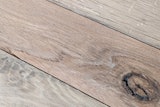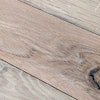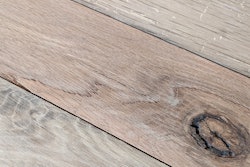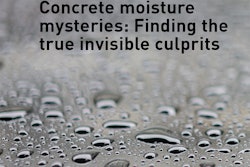The Problem
A customer had solid 5-inch Brazilian cherry hardwood installed in her home. At first she was thrilled, writing a letter to the store and thanking the installer for doing such a fine job. Soon, however, her joy turned to frustration as gaps started appearing throughout the floor. As months went on, the gaps worsened, and she asked the retailer to fix her floor. The flooring store felt the gaps were related to the cold weather and low humidity, but the customer stated she had a humidifier running and wanted a professional second opinion.
The Procedure
The prefinished plank flooring acclimated on the job site for 14 days before installation in the home’s kitchen, dining room and hallway in fall. There was about 800 feet of the solid ¾-inch flooring installed with 2-inch cleats over a ¾-inch plywood subfloor that was over a basement. The contractor did moisture and humidity testing prior to installation, recording his results in writing. Everything was in normal ranges: RH at 45% on average, and MC of the flooring and subflooring varied from 8.5 to 9.5%. He also used a professional-grade felt underlayment.
The Cause
The customer did have a humidifier running, but after checking to be sure it was working, I found it set to its lowest setting.
It was March by the time I did my inspection. Using feeler gauges, I found the gaps ranged from 0.026–0.045 inch throughout. While there, I measured several 10-board spans that were between 50 and 50 1⁄6 inch from leading edge to leading edge. I measured several boards with my calipers set in thousandths of an inch increments and found a correspondence between the gaps and the individual board sizes: They were measuring almost exactly the shrinkage distance adjacent to the gaps. The RH levels averaged 30%. MC in the flooring was 6%, and the subfloor was at 7%. The customer did have a humidifier running, but after checking to be sure it was working, I found it set to its lowest setting. I also checked with the installer to make sure he used the correct species adjustment on his moisture meter; I found he was aware of the need to adjust based on species and had set his meter appropriately for Brazilian cherry.
Because the gapping was uniform, it was apparent this was a simple but common case of the flooring shrinking in service due to low humidity in the home. Although the humidity reading at time of install and the reading I took in March both were within the 30–50% allowed, 5-inch plank can show gapping when a change of more than 2 percentage points occurs. Using the change dimension coefficient of 0.003 for Brazilian cherry, 5-inch segments could shrink or swell .015 inches per 1% MC change. The floor’s MC changed anywhere from 2.5–3.5% from the time of installation until the time of inspection. A dip of just 3% in the MC would cause the floor planks to shrink about 0.045 inches, which is consistent with what I found throughout the home.
How to Fix the Floor
Because the gaps were within the range of what is considered “normal” for wood floors and there was no permanent damage to the floor, my advice to the homeowner was to adjust her humidifier to a more appropriate level of about 35% and be patient. The gaps would begin to close as the RH started to rise.
In the Future
In our Midwestern area, especially with 5-inch material, it is best to try to maintain an interior home environment between 35–45%. This minimizes changes in the wood’s width as the RH changes seasonally. A humidifier/dehumidifier combination is a great way to achieve this, although customers should be sure to get them serviced yearly to maintain them in working condition.
RELATED: How to Prevent Wood Floor Gaps in Winter


































